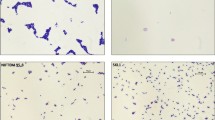Abstract
The genetic basis of the fungicidal activity of strains ofLactobacillus brevis andL. fermentum isolated from indigenous fermented foods was determined. A 5.5-kb plasmid was isolated fromL. brevis whileL. fermentum was found to harbor no plasmid. Plasmid curing indicated no correlation between the plasmid and the fungicidal activity of theLactobacillus species. The fungicidal activity of the isolated organisms can be supposed to be mediated by the chromosome. No antibiotic resistance genetic markers were detected on the plasmid and hence it was classified as cryptic.
Similar content being viewed by others
References
Anderson D.G., McKay L.L.: Simple and rapid method for isolating large plasmid DNA from lactic streptococci.Appl.Environ.Microbiol.46, 549–552 (1983).
Belicová A., Krajčovič J., Dobias J., Ebringer L.: Antimutagenicity of milk fermented byEnterococcus faecium.Folia Microbiol.44, 513–518 (1999).
Chassy B.M.: Prospects for improving economically significantLactobacillus strains by genetic technology.Trends Biotechnol.3, 273–275 (1985).
Fons M., Hege T., Ladire M., Raibaud P., Ducluzeau R., Maguin E.: Isolation and characterization of a plasmid fromLactobacillus fermentum conferring erythromycin resistance.Plasmid37, 199–203 (1997).
Kok J., Venema G.: Genetics of proteinases of lactic acid bacteria.Biochimie70, 475–488 (1988).
Lauková A., Czikková S., Burdová O.: Anti-staphylococcal effect of enterocin in Sunar® and yogurt.Folia Microbiol.44, 707–712 (1999).
Lauková A., Vlaemynck G., Czikková S.: Effect of enterocin CCM 4231 onListeria monocytogenes in Saint-Paulin cheese.Folia Microbiol.46, 157–160 (2001).
Lee-Wickner L.J., Chassy B.M.: Characterization and molecular cloning of crystic plasmids isolated fromLactobacillus casei.Appl.Environ.Microbiol.49, 1154–1161 (1985).
Lin C.F., Fung Z.F., Wu C.L., Chung T.C.: Molecular characterization of a plasmid-borne (pTC82) chloramphenicol resistance determinant (cat-TC) fromLactobacillus reuteri G4.Plasmid36, 116–124 (1996)
Macrina F.L., Kopecko D.J., Jones K.R., Ayers D.J., McCowen S.M.: A multiple plasmid-containingEscherichia coli strain: convenient source of size reference plasmid molecules.Plasmid1, 417–420 (1978).
de Man J.C., Rogosa M., Sharpe M.E.: A medium for cultivation of lactobacilli.J.Appl.Bacteriol.23, 130–135 (1960).
Morelli L., Vescovo M., Cocconcelli P.S., Bottazzi V.: Fast and slow milk-coagulating variants ofLactobacillus helveticus HLM1.Can.J.Microbiol.32, 758–760 (1986).
Mortvedt C.I., Nes I.F.: Plasmid-associated bacteriocin production by aLactobacillus sake strain.J.Gen.Microbiol.136, 1601–1607 (1990).
Olasupo N.A., Olukoya D.K., Odunfa S.A.: Plasmid profiles of bacteriocin-producingLactobacillus isolates from African fermented foods.Folia Microbiol.39, 181–186 (1994).
Osuntoki A.A., Olukoya D.K., Gbenle G.O., Omonigbehin E.A.: Isolation ofLactobacillus species with antifungal activity from Nigerian fermented foods.Nig.Quart.J.Hosp.Med.9, 314–316 (1999).
Pantev A., Kabadjova P., Dalgalarrondo M., Haertlé T., Ivanova I., Dousset X., Prévost H., Chobert J.-M.: Isolation and partial characterization of an antibacterial substance produced byEnterococcus faecium.Folia Microbiol.47, 391–400 (2002).
Schillinger U., Lucke F.K.: Antibacterial activity ofLactobacillus sake isolated from meat.Appl.Environ.Microbiol.55, 1901–1906 (1989).
Stanisich V.A.: Identification and analysis of plasmids at the genetic level.Meth.Microbiol.21, 11–47 (1988).
Tichaczek P.S., Nissen-Meyer J.N., Nes I.F., Vogel R.F., Hammes W.P.: Characterization of bacteriocin curvacin A fromLactobacillus curvatus LTH 174 and sakacin P fromL. sake LTH 673.Syst.Appl.Microbiol.15, 460–468 (1992).
West C.A., Warner P.J.: Plasmid profiles and transfer of plasmid-encoded antibiotic resistance inLactobacillus plantarum.Appl.Environ.Microbiol.50, 1319–1321 (1985).
Author information
Authors and Affiliations
Rights and permissions
About this article
Cite this article
Osuntoki, A.A., Gbenle, G.O. & Olukoya, D.K. Evidence for chromosomal determination of fungicidal activity in strains ofLactobacillus brevis andLactobacillus fermentum isolated from fermented foods. Folia Microbiol 48, 56–58 (2003). https://doi.org/10.1007/BF02931276
Received:
Revised:
Issue Date:
DOI: https://doi.org/10.1007/BF02931276




